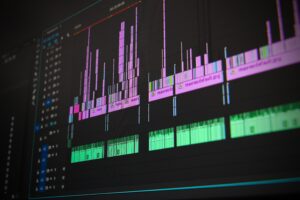Exploring the Art of Storytelling through Motion Graphics in Marketing Campaigns
Welcome to the fascinating world of storytelling through motion graphics in marketing campaigns! In an era where attention spans are shorter than ever, captivating your audience has become an art form. And what better way to do it than by combining the power of visuals with the magic of a well-crafted narrative?
Motion graphics have quickly become a game-changing tool for marketers, breathing life into brands and leaving lasting impressions on consumers. So, grab your popcorn and dive deep into this enchanting realm of creativity as we explore how motion graphics can revolutionize your marketing efforts and create a story that resonates with hearts and minds alike.
Why is storytelling essential in marketing?
Storytelling has been an essential part of human communication since the beginning. It is a powerful tool that enables us to share our experiences, values, and beliefs with others. In today’s digital age, storytelling is crucial in marketing campaigns. It helps brands connect with their audience deeper and create a lasting impression.
So why is storytelling important in marketing? Firstly, it allows brands to stand out in a cluttered market. With the rise of social media and digital platforms, consumers are exposed to hundreds of ads daily. In such a competitive environment, traditional marketing techniques may not be enough to capture their attention. This is where storytelling comes into play – by creating compelling narratives that resonate with the target audience; brands can differentiate themselves from their competitors.
Moreover, storytelling adds depth and emotion to brand messaging. People tend to remember stories more than facts or statistics because they evoke emotions and trigger memories. By incorporating storytelling into their marketing campaigns, brands can tap into customers’ emotions and create a connection with them. This emotional engagement leads to increased brand loyalty and customer retention.
The process of creating a motion graphics marketing campaign
Creating a motion graphics marketing campaign can be broken down into several key stages, each crucial in bringing the concept to life and delivering a successful campaign. This section will delve deeper into the steps of creating a motion graphics marketing campaign, from the initial idea to its final execution.
1. Concept Development:
Developing a solid and captivating concept is the first step in any marketing campaign. This involves understanding the target audience, identifying their needs and preferences, and crafting a story that resonates with them. The idea behind using motion graphics is to visually communicate the message in an engaging way that captures viewers’ attention and leaves a lasting impact.
2. Storyboarding:
Once the concept has been finalized, it’s time to bring it to life through storyboarding. This stage involves mapping out each scene or shot of the animation and accompanying audio elements such as music, sound effects, or voiceovers. Storyboarding helps visualize the final product and allows for necessary changes before moving on to production.
Tips for incorporating storytelling into your motion graphics design
Storytelling has been a fundamental part of human communication since the beginning. It is an art that has evolved and found its way into motion graphics design. Incorporating storytelling techniques into your motion graphics can elevate your marketing campaigns by creating a memorable and engaging experience for your audience.
Here are some tips to help you incorporate storytelling into your motion graphics design:
1. Start with a strong concept: Having a solid idea or story in mind is essential before jumping into the visual aspect. This will serve as the foundation for your entire design and ensure that all elements work together cohesively to convey the message effectively.
2. Know your target audience: Understanding who you create motion graphics for is crucial in storytelling. Take time to research and understand their interests, preferences, and behaviors. This will help you create a story that resonates with them more profoundly.
3. Create relatable characters: People connect more with stories when they see themselves portrayed in the characters. Whether through animation or live-action footage, create relatable characters and evoke emotions in your audience.
4. Use visuals to enhance the story: Motion graphics provide endless possibilities for bringing stories to life through visuals. Use different animation techniques, color schemes, and typography to improve the mood and tone of your account.
Exploring the different types of animation styles used in motion graphics
Motion graphics, also known as animated graphics or digital animation, have become increasingly popular in marketing. They allow businesses to create visually appealing and engaging content that captures the attention of their target audience. However, not all motion graphics are created equal – various styles and techniques are used in making them. This section will explore the different animation styles commonly used in motion graphics for marketing purposes.
- 2D Animation: This is one of the most traditional forms of animation and involves creating movement using two-dimensional images or drawings. It can be hand-drawn or created digitally using Adobe After Effects or Toon Boom Harmony software. 2D animations are often used in storytelling, ranging from simple illustrations to more complex designs with multiple layers and effects.
- 3D Animation: As the name suggests, this type of animation involves creating depth by adding a third dimension to the visuals. 3D animations are created using specialized software such as Maya, Blender, or Cinema 4D, allowing realistic modeling, lighting, and texturing. This style is widely used in advertisements for products that require a detailed showcase.




